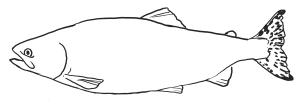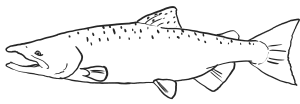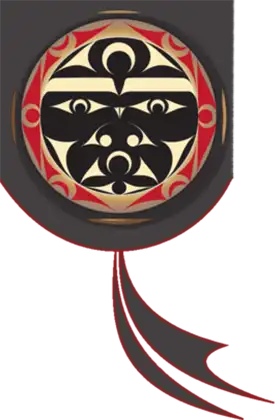Family Activity – Fish & Shellfish Lifecycle

How to filet a fish & cook seafood
Fish & Shellfish Unit
Families will explore fish and shellfish habitats and harvesting practices.
Lushootseed
čad kʷi dəxʷʔəsɬaɬlils. - Where does this live?
ʔəsɬaɬlil ti ____ ʔal ti ____. - ___ lives at ___.
x̌ʷəlč - Ocean
stuləkʷ - River
dᶻəɬixʷ - Creek
yubəč - King Salmon
scəqiʔ - Sockeye Salmon
skʷəxʷic - Silver (Coho) Salmon
ƛ̕xʷayʔ - Dog Salmon
həduʔ - Humpy Salmon
sʔax̌ʷuʔ - Clams
Activity Instructions
Things you Need for this activity:
• filet knife
• salmon of any kind depending on season
• optional: salmon berries & Washington native ferns
• a large cutting board
• something to cook the fish in (smoker, on fire, oven, fryer)
• access to x̌ʷəlč (saltwater) to return salmon bones back to the x̌ʷəlč.
• Watch "Fileting a Salmon for Smoking", dəxʷšuɬtxʷ (video) by: Thomas Williams. Watch Here
•Watch "Traditional method for cooking seafood" dəxʷšuɬtxʷ (video) Watch Here
• After watching the videos, work together as a family to filet your salmon and then prepare the fish for smoking.
• After you have completed the preparation, be sure to return the bones to the water. You can listen to the First Salmon Ceremony story to remember why this is important. Listen Here
• Enjoy the smoked fish together and share with others!

Visiting fish habitats
Fish and
Shellfish Unit
Families will explore fish and shellfish habitats and harvesting practices. They are important to the Tulalip people.
Lushootseed
čad kʷi dəxʷʔəsɬaɬlils - Where does this live?
ʔəsɬaɬlil ti ___ ʔal ti ____. - ___ lives at ___.
stab čəxʷ ʔəsšudxʷ. - What do you see?
ʔəsšudxʷ čəd ti ____. - I see ______.
čad kʷi dəxʷʔəsgʷəc ʔə ti sʔuladxʷ. - Where are salmon born?
x̌ʷəlč - Ocean
stuləkʷ - River
dᶻəɬixʷ - Creek
yubəč - King Salmon
scəqiʔ - Sockeye Salmon
skʷəxʷic - Silver (Coho)
ƛ̕xʷayʔ - Dog Salmon
həduʔ - Humpy Salmon
stab kʷi ləliʔ ʔə ti sʔuladxʷ. - What is different about this salmon?
stab kʷi diɬdiɬgʷas ʔə ti sʔuladxʷ. - What is the same about this salmon?
ləʔləliʔcut ti bək̓ʷ sʔuladxʷ. - All salmon change color.
Activity Instructions
 • Go to nearest river, creek and or ocean or visit all three.
• Go to nearest river, creek and or ocean or visit all three.
» Examples: Tulalip Marina, Hermosa Beach, Kayak Point, Spee-bi-dah, Camano Head, Port of Everett (hibulb), Stillaguamish River, Snohomish River, Tulalip Hatchery, Battle Creek (x̌ilix̌ dᶻəɬixʷ), Quilceda Creek.
• When you are at the beach, river and or creek you can use the language phrases with your children like stab čəxʷ ʔəsšudxʷ. (What do you see?) ʔəsšudxʷ čəd ti ____. (I see ______), čad kʷi dəxʷʔəsɬaɬlils. (Where does this live, and ʔəsɬaɬlil ti ___ ʔal (ti ____. - ___ lives at ___.)
• You can observe the fish habitats and determine whether the salmon in the area are river or ocean salmon. Ask others how they made their decision.
» čad kʷi dəxʷʔəsgʷəc ʔə ti sʔuladxʷ (Where are salmon born?) stuləkʷ (river) dᶻəɬixʷ (creek)
» Now that your family has identified the habitat and birthplace of the salmon, You can start looking for the differences between different salmon species. If there are no salmon in your area, you can use the example pictures to observe and compare the differences.
» stab kʷi ləliʔ ʔə ti sʔuladxʷ
(What is different about this salmon?)
» stab kʷi diɬdiɬgʷas ʔə ti sʔuladxʷ
(What is the same about this salmon)
» ləʔləliʔcut ti bək̓ʷ sʔuladxʷ
(All salmon change color)


Family and intergenerational learning
The beach, rivers and creeks are a great place for families to join and gather together, our families in Tulalip have always lived, gathered, and fished from these areas. If some children are non-verbal or physically challenged they still can enjoy the culture part of the activity of exploring the habitats along with the rest of the family. Reminder that when we are in animals’ natural habitats we should leave it the way we found it so leave no trace and be respectful.
Local Place Connections
Tulalip Reservation has a number of beaches, rivers, and creeks for families to enjoy, as we have always done. Consider visiting the Tulalip marina, Mission Beach (ghost point), Hermosa Beach, Tulare Beach, (sbiʔbədaʔ), Kayak Point, Priest Point Beach, Camano Head, Port of Everett (hibulb), Stillaguamish River, Snohomish River, Tulalip Hatchery, Battle Creek (x̌ilix̌ dᶻəɬixʷ), Jones Creek (Ebey Park), Quilceda Creek, or other family waterfront areas. Talk with your family, friends and other tribal citizens if you have questions about beach access and permissions.
Tulalip Life skills:
These locations offer insight into life a long time ago. These places like many others are still visited for fishing, gathering, and many other activities. They continue to hold importance because of connections from our ancestors and from our own families that hold these places in high regard. Many people still practice fishing just like our Ancestors did.

Clam Shell Rattles
Fish & Shellfish Unit
Families will explore fish and shellfish habitats and harvesting practices.
Lushootseed
sʔax̌ʷuʔ - Clams
tulqʷ - Mussel
č̓awəyʔaɬəd - Shrimp
ƛ̕ux̌ʷƛ̕ux̌ʷ - Oyster
bəsqʷ - Crab
c̓ubc̓ub - Barnacle
sč̓awəyʔ - Seashell
kiyuuqʷs – Seagull
buʔqʷ - Duck
ɬulək̓ʷit̕ čəɬ. - We are going to the shore.
ɬugʷəč̓əd čəɬ ti č̓aywəyʔaɬəd. - We are going to look for shellfish.
stab tiʔəʔ - What is this?
____ tiʔəʔ. - This is a ___.
____ dəgʷi, gʷat čəxʷ ʔuʔəy̓dxʷ - Hey ____, who did you find?
Activity Instructions
Procedures/Instructions
1. č̓uʔ: Print or review Lushootseed vocabulary. Pack up anything you might need for the beach.
2. saliʔ: Travel to the beach (ɬulək̓ʷit̕ čəɬ), any local beach will do, to give your family a wonderful time exploring and observing together. Be sure to check water quality and ʔilgʷiɬ (beach) warnings to be informed about any safety issues such as red tide. Reminder that when we are in animals’ natural habitats, we should leave it the way we found it. So leave no trace and be respectful.
3. ɬixʷ: Tell your family that you are going to look for shellfish (ɬugʷəč̓əd čəɬ ti sč̓awəyʔ). When you are at the beach search for shellfish like; sʔax̌ʷuʔ
Clams, tulqʷ
Mussel, č̓awəyʔaɬəd
Shrimp, ƛ̕ux̌ʷƛ̕ux̌ʷ
Oyster, bəsqʷ
Crab, ćubćub
Barnacle, sč̓awəyʔ
Seashell, kiyuuqʷs
Seagull, buʔqʷ
Duck, using the phrases: stab tiʔəʔ
(What is this?), ____ tiʔəʔ.
(This is a ___), and ____ dəgʷi, gʷat čəxʷ ʔuʔəy̓dxʷ.
(Hey ____, who did you find?)
4. buus: For each rattle you need two sč́awəyʔ
(shells) that match together or are similar in size, you will also need to collect č̓ƛ̕č̓ƛ̕aʔ
rocks from the beach to fill your rattle. You will need hot glue to seal your edges, and sinew string to wrap the rattle.
5. cəlac: Now its time to put it together, grab your clam shells sʔax̌ʷuʔ č̓awəyʔ and fill them with rocks. Now hot glue the rim of one shell and push the two shells together until dry. Lastly, wrap the sinew around the shell sʔaxʷ̌ uʔ sč̓awəyʔ until it feels tight. Now you have a rattle for the First Salmon Ceremony!
Family and intergenerational learning
The beach is a great place for families to join and gather together, our families in Tulalip have always lived, gathered, and fished from these areas. Some beaches have access with parking that can be easier when elders or family with mobility challenges join. If you couldn’t participate in the collecting of the shells sʔax̌ʷuʔ č̓awəyʔ the next part of the activity doesn't require any physically challenging elements.
Local Place Connections
Tulalip Reservation has a number of beaches for families to enjoy, as we have always done. Consider visiting the Tulalip Marina, Mission Beach (ghost point), Hermosa Beach, Tulare Beach, sbiʔbədaʔ, Kayak Point, Priest Point Beach, Camano Head, Port of Everett (hibulb), or other family waterfront areas. Talk with your family, friends and other tribal citizens if you have questions about beach access and permissions.
huyadadčəɫ:
These locations offer insight into life a long time ago. These places like many others are still visited for fishing, gathering, and many other activities. They continue to hold importance because of connections from our ancestors and from our own families that hold these places in high regard. Many people still carry on our traditional practices just like our Ancestors did.



